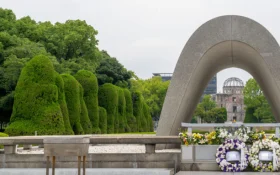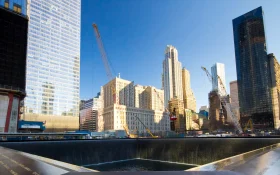Beyond the Shadows: Dark Tourism’s Haunting Destinations

Blades of Honor: Unveiling the Mighty Ancient Samurai In Japan
July 5, 2023
Isaac Newton and His Fascination with Alchemy: The Mysteries of His Hidden Pursuit
July 22, 2023Dark tourism, also known as thana tourism, is a unique form of travel that involves visiting places associated with death, tragedy, or other morbid events. It encompasses sites such as battlefields, crime scenes, disaster areas, cemeteries, haunted locations, and former concentration camps. The term “dark tourism” was coined by British academic John Lennon in 1996, and since then, it has gained increasing popularity among tourists seeking unconventional and thought-provoking experiences.
The allure of dark tourism lies in its ability to offer a glimpse into history’s darker chapters and evoke emotions such as curiosity, fascination, and contemplation. These destinations often hold significant historical, cultural, or social importance, providing visitors with a deeper understanding of past events and their impact on societies.
One of the most well-known examples of dark tourism is the Auschwitz concentration camp in Poland. Millions of people visit this site annually to pay tribute to the victims of the Holocaust and to learn about the atrocities committed during World War II. Such places serve as powerful reminders of the human capacity for both great suffering and resilience.
Dark tourism can also encompass sites of natural disasters, like the Chernobyl Exclusion Zone in Ukraine, where the catastrophic nuclear accident occurred in 1986. In recent years, interest in this location has surged, partly due to its depiction in popular media. Tourists are drawn to the eerie beauty of the abandoned city of Pripyat and the opportunity to witness firsthand the impact of the worst nuclear disaster in history.
Critics of dark tourism argue that it can be exploitative and insensitive, commodifying tragedy for profit and entertainment. Concerns have been raised about the ethical implications of turning sites of death and suffering into tourist attractions.
However, proponents of dark tourism contend that these visits can be educational and foster empathy and awareness. When done responsibly and respectfully, dark tourism can help preserve historical memory and contribute to the economic development of local communities.
To ensure that dark tourism is conducted ethically and respectfully, tourists and tour operators must approach these sites with sensitivity, empathy, and a commitment to preserving the dignity of the victims and their legacies. Local communities should be actively involved in shaping the narrative and management of these destinations, allowing for healing, reconciliation, and memorialization.
IDark tourism, or thana tourism, is a distinctive form of travel that invites visitors to engage with history’s somber aspects. It offers an opportunity for reflection, understanding, and remembrance of significant events, both natural and human-made. While the concept of dark tourism is not without controversy, it has the potential to foster empathy, awareness, and preservation of collective memory, provided it is approached with respect and sensitivity to the solemnity of these sites.
Read About: Exploring Tunisia’s Mysterious Lake
Here are some more examples of dark tourism destinations:
- The Catacombs of Paris, France
- Tuol Sleng Genocide Museum, Cambodia
- The Tower of London, England
- Chernobyl Nuclear Power Plant, Ukraine
- Anne Frank House, Amsterdam, Netherlands
- Robben Island, South Africa
- Hiroshima Peace Memorial Park, Japan
- The Killing Fields, Cambodia
- Ground Zero, New York City, USA
- Ground Zero, New York City, USA: The site of the 9/11 terrorist attacks on the World Trade Center towers in 2001 attracts millions of visitors annually. The 9/11 Memorial and Museum provides a somber tribute to the victims and a profound reflection on the impact of the tragic event on the world.
- The Killing Fields, Cambodia: Located near Phnom Penh, the Killing Fields are a poignant reminder of the atrocities committed during the Khmer Rouge regime in the 1970s. Tourists visit to learn about the Cambodian genocide and pay their respects to the millions of people who lost their lives.
- Hiroshima Peace Memorial Park, Japan: This park commemorates the victims of the atomic bombing of Hiroshima during World War II. Visitors can explore the Peace Memorial Museum and reflect on the devastating consequences of nuclear warfare.
- Robben Island, South Africa: Robben Island, located off the coast of Cape Town, was once a prison where anti-apartheid activists, including Nelson Mandela, were incarcerated. It now serves as a museum and UNESCO World Heritage site, attracting visitors to learn about South Africa’s struggle for freedom and democracy.
- Anne Frank House, Amsterdam, Netherlands: The house where Anne Frank and her family hid during the Holocaust is now a museum, offering a poignant insight into the life of the young Jewish girl and the horrors of the Holocaust.
- Chernobyl Nuclear Power Plant, Ukraine: In addition to the Chernobyl Exclusion Zone, tourists can visit the Chernobyl Nuclear Power Plant itself to learn about the causes and aftermath of the nuclear disaster.
- The Tower of London, England: This historic fortress has a dark history of executions, imprisonment, and torture. Visitors can explore the Bloody Tower, where several high-profile prisoners were held, including Anne Boleyn and Lady Jane Grey.
- Tuol Sleng Genocide Museum, Cambodia: Formerly a high school, Tuol Sleng was turned into a prison during the Khmer Rouge regime. The museum displays photographs and exhibits that document the horrors endured by prisoners.
- The Catacombs of Paris, France: This underground ossuary contains the remains of more than six million people. It serves as a macabre reminder of mortality and attracts tourists interested in its historical significance.
Dark tourism destinations offer visitors the opportunity to confront difficult aspects of history, allowing for reflection, education, and a deeper understanding of human experiences. While visiting these sites, it is essential to approach them with respect and sensitivity to the significance they hold for the affected communities and the broader historical context.













